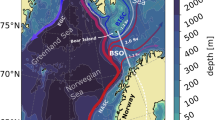Abstract
The annual obduction rate enhancement induced by tropical cyclones is estimated on the basis of SODA outputs and tropical cyclone-induced mixed layer deepening obtained from a hurricane–ocean coupled model. Averaged over the period from 1984 to 2005, the obduction rate enhancement is estimated to be 2.1 Sv in the North Atlantic and 4.2 Sv in the North Pacific; such enhancement is mainly confined to the latitudinal band from 10°N to 30°N. The obduction rate enhancement induced by tropical cyclones in the North Atlantic and North Pacific both show strong interannual variability, which is mainly dominated by powerful hurricanes/typhoons.




Similar content being viewed by others
References
Camargo SJ, Sobel AH (2005) Western North Pacific tropical cyclone intensity and ENSO. J Clim 18:2996–3006
Carton JA, Giese BS (2008) A reanalysis of ocean climate using SODA. Mon Weather Rev 136:2999–3017
Carton JA, Giese BS, Grodsky SA (2005) Sea level rise and the warming of the oceans in the SODA ocean reanalysis. J Geophys Res 110:C09006. doi:10.1029/2004JC002817
Chan JCL, Liu KS (2004) Global warming and western North Pacific typhoon activity from an observation perspective. J Clim 17:4590–4602
Cooper C, Thompson JD (1989) Hurricane-generated currents on the outer continental shelf. Part I: model formulation and verification. J Geophys Res 94:12513–12539
Cushman-Roisin B (1987) Subduction. In: Muller P, Henderson D (eds) Dynamics of the oceanic surface mixed layer. Hawaii Institute of Geophysics Special Publications, London, pp 181–196
Emanuel KA (1989) The finite amplitude nature of tropical cyclogenesis. J Atmos Sci 46:3431–3456
Emanuel KA (2001) The contribution of tropical cyclones to the oceans’ meridional heat transport. J Geophys Res 106(D14):14771–14781
Hazeleger W, Drijfhout SS (2000) Eddy subduction in a model of the subtropical gyre. J Phys Oceanogr 30:677–695
Karstensen J, Quadfasel D (2002) Formation of South Hemisphere thermocline waters: water mass conversion and subduction. J Phys Oceanogr 32:3020–3038
Liu LL, Huang RX (2012) The global subduction/obduction rates, their interannual and decadal variability. J Clim 25:1096–1115
Liu LL, Wang W, Huang RX (2008) The mechanical energy input to the ocean induced by tropical cyclones. J Phys Oceanogr 38:1253–1266
Liu LL, Huang RX, Wang F (2011a) The role of diurnal cycle in subduction/obduction. J Oceanogr 67:273–279
Liu LL, Wang F, Huang RX (2011b) Enhancement of subduction/obduction due to hurricane-induced mixed layer deepening. Deep Sea Res I 58:658–667
Marshall D (1997) Subduction of water masses in an eddying ocean. J Mar Res 55:201–222
Nelson NB (1998) Spatial and temporal extent of sea surface temperature modifications by hurricanes in the Sargasso Sea during the 1995 season. Mon Weather Rev 126:1364–1368
Price JF, Morzel J, Niiler PP (2008) Warming of SST in the cool wake of a moving hurricane. J Geophys Res 113:C07010. doi:10.1029/2007JC004393
Qiu B, Huang RX (1995) Ventilation of the North Atlantic and North Pacific: subduction versus obduction. J Phys Oceanogr 25:2374–2390
Qu T, Xie S-P, Mitsudera H, Ishida A (2002) Subduction of the North Pacific mode waters in a global high-resolution GCM. J Phys Oceanogr 32:746–763
Schade LR, Emanuel KA (1999) The ocean’s effect on the intensity of tropical cyclones: results from a simple coupled atmosphere-ocean model. J Atmos Sci 46:642–651
Wang B, Chan JCL (2002) How strong ENSO events affect tropical storm activity over the western North Pacific. J Clim 15:1643–1658
Woods JD (1985) The physics of pycnocline ventilation. In: Nihoul JCJ (ed) Coupled ocean-atmosphere models. Elsevier, London, pp 543–590
Acknowledgments
This work was supported by The Key State Basic Research Program of China under Grant 2013CB430303, The Strategic Priority Research Project (Grant XDA11010201), National Natural Science Foundation of China under Grant 41276001, and The Key State Basic Research Program of China (2012CB417401).
Author information
Authors and Affiliations
Corresponding author
Rights and permissions
About this article
Cite this article
Liu, L.L., Wang, F. Tropical cyclone-induced vertical water transfer and its variability in the North Atlantic and North Pacific. J Oceanogr 71, 401–407 (2015). https://doi.org/10.1007/s10872-015-0299-z
Received:
Revised:
Accepted:
Published:
Issue Date:
DOI: https://doi.org/10.1007/s10872-015-0299-z



